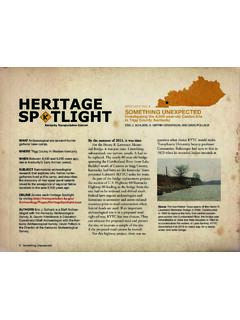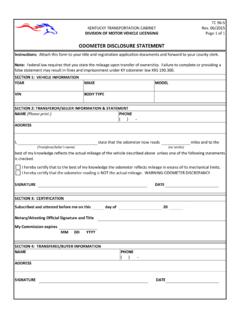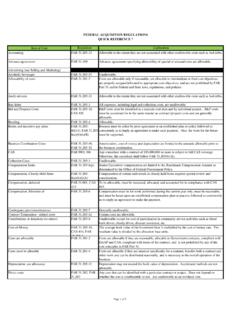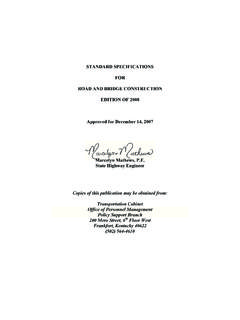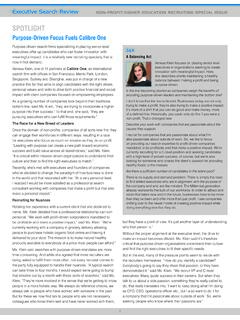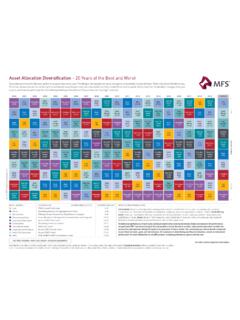Transcription of SPOTLIGHT NO. UNCOVERING THE LIVES OF KENTUCK'S …
1 By the early to mid-1800s, Kentucky had left her frontier roots behind. The cities of Lex-ington and Louisville were bustling places of commerce and culture. Still, the fifteenth state was mainly rural, and most Kentuckians were 20 percent of Kentucky s resi-dents at this time were enslaved people of African descent. These people cleared and worked the land. They built elegant houses. They were accomplished carpen-ters and seamstresses. But they did not own the land they worked, did not real-ize the profits from their labor, and did not call those elegant houses home. They were called is known about Kentucky s wealthy, white, male, landowners of the Antebellum period.
2 Their names and faces commonly appear in our history books and art museums. We know much less about the enslaved people who worked for them; and what we do know is too often told from the slaveholders archaeologists are working to change ArchaeologyTo learn about how European American and African American people lived in Ken-tucky long ago, historical archaeologists study artifacts (objects made or modified by people). They study artifact disposal patterns (where artifacts are found and what they are found with) for the clues they hold. They also study oral histories and documents like maps, diaries, let-ters, books, wills, and tax NO.
3 5 UNCOVERING THE LIVES OFKENTUCKY'S ENSLAVED PEOPLE M. JAY STOTTMAN AND LORI C. STAHLGRENWHAT Archaeological Site (the domestic nucleus of a typical Kentucky plantation).WHERE Jessamine County in Central Early to late nineteenth century (Kentucky's Antebellum period).SUBJECT Summary of archaeological research on plantation layout and on the lifeways of enslaved African Access each Heritage SPOTLIGHT by visiting M. Jay Stottman is Senior Staff Archae-ologist with the Kentucky Archaeological Survey. Lori C. Stahlgren is Staff Archaeologist with the Kentucky Archaeological Transportation Cabinet1 Kentucky's Enslaved PeopleThe written record is very limited for poor people and for enslaved people.
4 These groups are almost invisible in Kentucky history, and when they do ap-pear, history offers a narrow and biased view of their LIVES . Therefore, the arti-facts they left behind and the patterns of those artifacts at the places they lived and worked must tell their 2002, the Kentucky Department of Transportation planned to widen Highway 68 in northern Jessamine County. This project gave historical archaeolo-gists the opportunity to research Mason Barkley s plantation a typical nineteenth-century Kentucky plantation owned by a white man and the enslaved black men, women, and children who lived and worked there. This SPOTLIGHT presents what historical archaeologists learned as a result of this research.
5 It offers a richer and more inclusive perspective on Kentucky s in KentuckyIn the late 1700s, the younger sons of wealthy white East Coast planters, dream-ing of establishing their own farms, had little hope for success if they stayed near home and kin. Central Kentucky presented a remarkable opportunity. These men joined the flood of immigrants moving west. They brought with them the planta-tion system, a system founded on time, this system became the model for Kentucky agriculture. Owning enslaved people became an integral part of Kentucky culture and its agricultural term plantation system brings to mind expansive Antebellum cotton-producing operations owned by wealthy white families living in lavish man-sions.
6 It suggests an image of hundreds of enslaved Africans brought against their will to work in the cotton fields of America s Deep South Alabama, Georgia, Mississippi, and is a stereotype. It does little to help us understand the South s large plantations or central Kentucky s much smaller topography, soils, and climate in central Kentucky were not suitable for growing cotton, rice, or sugar cane. Therefore, farmers in the region grew corn, wheat, oats, barley, and hay. In addition, they raised vegetables and fruits, and tended livestock, like cattle, pigs, sheep, and horses. In some cases, they also grew cash crops, like tobacco and/or hemp (see sidebar on page 4).
7 What made a Kentucky farm a plan-tation? It was not the amount of land it covered or the types of crops it produced. On a farm, laborers were free people, and Above African slave. Enslaved African. Do labels make that much difference? They can, because labels encode subtle messages. Throughout this SPOTLIGHT , enslaved is used instead of slave. 2 Kentucky's Enslaved Peoplethey were paid for their work. A planta-tion, in contrast, relied on an institutional-ized (structured and highly formalized) forced labor system race-based slavery. These laborers were property and they belonged to the plantation owner. In this respect, Kentucky plantations were ex-actly like their Southern Plantation SlaveryMost Kentuckians did not own enslaved people.
8 Primarily wealthy white men did men like Henry Clay, John Rowan, Isaac Shelby, John Speed, and George Rogers Clark. Between 20 and 50 enslaved blacks worked on Kentucky s largest plantations. Typically, however, only four enslaved people lived and worked on a plantation in ranged from domestic work (cooking, washing, cleaning, minding the children, being personal servants), to tend-ing livestock, to working the fields, often side-by-side with their owners. Women were seamstresses, cooks, herbalists, and midwives. Men were tradesmen skilled in carpentry, masonry, brick making, and horse training. Slaveholders, on occa-sion, leased out individuals with these skills to other farms and Amec Foster Wheeler archaeologists excavate in a rectangular unit at the Barkley Plantation Site in 2005-2006.
9 Excavation is just the first step in a long process of research and discovery. Using shovels and trowels, archaeologists excavate slowly and carefully, finding artifacts by screening the dirt through wire screens. The bulk of archaeological research, however, takes place after the excavation is finished. Investiga-tors spend months collecting and analyzing data and carrying out comparative research. Only then can they develop interpretations about a site and its residents, its history of occupation, and the kinds of activities that took place there. 3 Kentucky's Enslaved PeopleIndustrial Hemp Barkley's Cash CropKentucky s climate was well-suited to industrial hemp production.
10 A valuable cash crop, hemp was cultivated for its fibers. Bluegrass farmers often grew the tall, stalky plant on their richest played an important role in Kentucky s nine-teenth-century farm economy. During the first half of the century, the rise in demand for cotton increased the demand for hemp bags used for bagging cotton and for hemp twine and rope used for binding it. Kentuck-ians like Mason Barkley, who enslaved many people, grew large amounts of hemp before market prices fell in the early and processing hemp was very hard, inten-sive work. Only the strongest could do it and do it day after day. For these reasons, hemp growers relied almost exclusively on enslaved labor.
